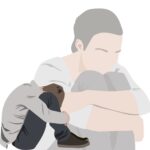Specific phobia is an anxiety condition in which a person is overly afraid of a certain thing, situation, or action for no good reason. Anxiety is more than just being scared, it makes people avoid things. The level of fear is often too high compared to the real threat that the phobic trigger poses. For example, acrophobia is the fear of heights, arachnophobia is the fear of spiders, aviophobia is the fear of flying, and trypanophobia is the fear of needles. People with certain fears may have severe anxiety or panic attacks when they are around the thing or setting they are afraid of.
Studies show that between 3% and 15% of people around the world have unique phobias at some point in their lives. The most common phobias and fears are of heights and animals. According to the stages of development of phobias, which go from fear to avoidance to identification, stopping the stages of development could lower the number of people who have them. Some fears start in youth, but most people get them in middle age and old age. 10 to 30 percent of people with phobias have them for years or even decades, and they are a strong indicator of the development of other anxiety, mood, or substance-use problems. Since phobias are often linked to other mental disorders, especially after the fear starts, treating them early may also change the risk of other disorders.
Hence, early diagnosis and treatment of specific phobias is crucial. Mentioned below are the diagnostic criteria and features of specific phobia disorders in light of DSM 5 TR:
Diagnostic Criteria
A. A clear fear or worry about a certain thing or event, like flying, heights, animals, getting an injection, or seeing blood.
When kids are scared or anxious, they might cry, throw fits, freeze up, or stick to you.
B. The phobic thing or situation almost always makes the person feel scared or anxious right away.
C. The person or thing that causes the phobia is actively avoided or goes through it with a lot of fear or worry.
D. The worry or fear is too high compared to the real danger of the thing or situation and the social and cultural setting.
E. The fear, worry, or delay doesn’t go away and usually lasts for at least six months.
F. Fear, worry, or avoidance that makes it hard to function in social, professional, or other important areas of life is therapeutically significant.
G. It is not clear that the problem is caused by the signs of another mental disorder, like fear, anxiety, and avoiding situations that cause panic attacks or other symptoms that make it hard to do things (as in agoraphobia); objects or situations that cause obsessions (as in obsessive-compulsive disorder); reminders of traumatic events (as in post-traumatic stress disorder); being away from home or attachment figures (as in separation anxiety disorder); or social situations (as in social anxiety disorder).
Diagnostic Features
- The syndrome is particularly notable for its confined dread or anxiety to a specific event or item (Criterion A), termed the phobic stimulus.
- Many people have many phobias. The reaction must be different from usual, short-lived concerns to be diagnosed with a particular phobia.
- For a diagnosis (Criterion A), fear or concern must be very severe (i.e., “marked”).
- Depending on how near someone is to the object or circumstance they are scared of, they may feel fearful before, during, or after being around it.
- A predicted or complete panic attack may also result from stress or dread.
- A specific phobia is also characterized by feeling terrified or nervous virtually every time they see or hear the trigger (Criterion B). Thus, someone who only gets terrified when they see or hear an object or event (like on one out of five airline journeys) does not have a particular phobia.
- Anxiety can range from anticipatory to complete panic attacks, depending on the individual and environment.
- There are other people around them, the amount of time they are exposed to the phobic object or circumstance, and terrifying things like turbulence on a trip for flying phobics.
- Children and adults express fear and concern differently.
- To make matters worse, fear or concern begins when the phobic object or event is seen or experienced.
- The individual avoids the circumstance or thing, or if they cannot, it scares them (Criterion C).
- People who avoid phobic objects or circumstances do so intentionally. For instance, someone frightened of heights could take tunnels instead of bridges to work, someone afraid of spiders might avoid dark rooms, and someone terrified of spiders might not work in a phobic environment.
- Avoidance tactics like not going to the doctor because of blood are obvious.
- Sometimes they are unclear, like a snake-phobic person not looking at snake photographs.
- Specific phobia sufferers have often moved to avoid the dreaded object or scenario.
- Someone with an animal fear may migrate to a region without them. Their daily lives are no longer filled with anxiety and stress.
- If there is no evident anxiety or fear, avoidance or refusal to do activities that would place the phobic person or item in a position may assist in establishing the diagnosis.
- Rejecting work-related travel opportunities due to a fear of flying may indicate this.
- The object or circumstance causes too much anxiety or worry or is stronger than necessary (Criteria D).
- The therapist thinks that certain phobia sufferers’ emotions are out of proportion because they exaggerate how deadly their fears are.
- In regions with high rates of violence, fear of the dark makes sense, while unjust fear of insects is stronger in places where people consume them.
- The disorder is distinguished from typical, short-lived worries that most people feel, especially youngsters since the dread, worry, or avoidance lasts at least six months (Criterion E).
- The specific phobia must produce clinical discomfort or issues in social, work, or other essential areas of functioning to identify the illness (Item F).
I am a passionate and knowledgeable psychologist, with a Master of Philosophy (MPhil) in Psychology specializing in Counseling Psychology. Through my writing, I share my insights and thoughts on various psychiatric disorders, conduct analysis on films that touch on psychological issues, and explore other topics related to psychology, while also providing valuable information to psychology enthusiasts, students as well the general community.





